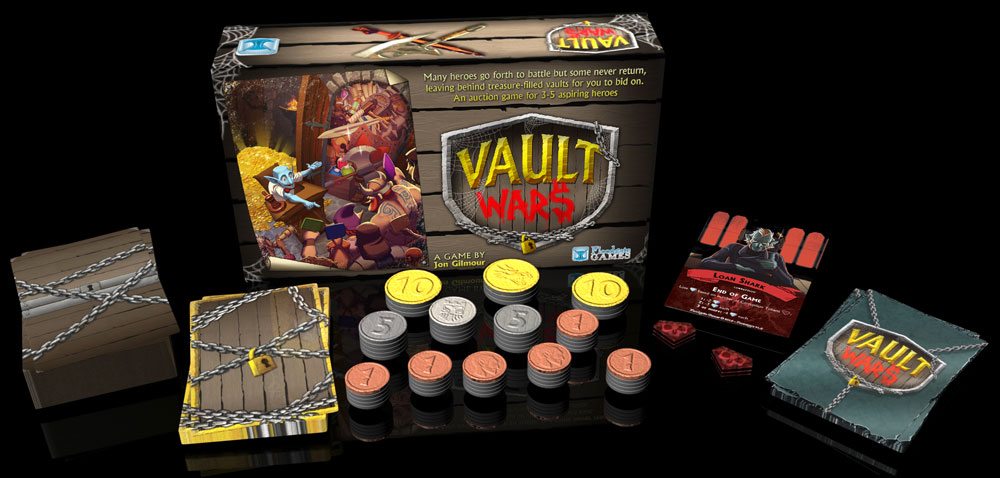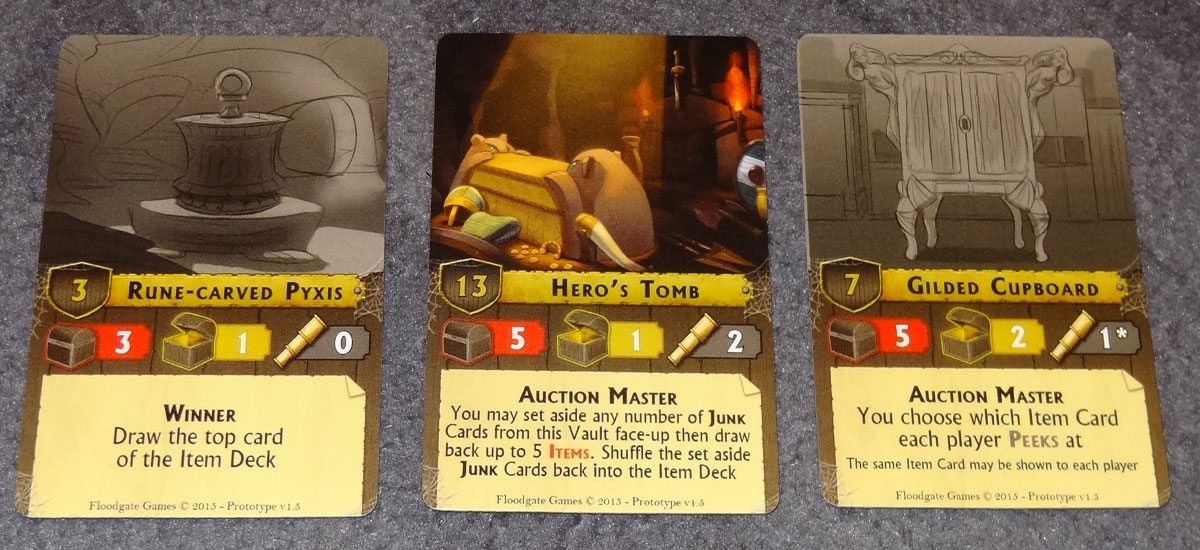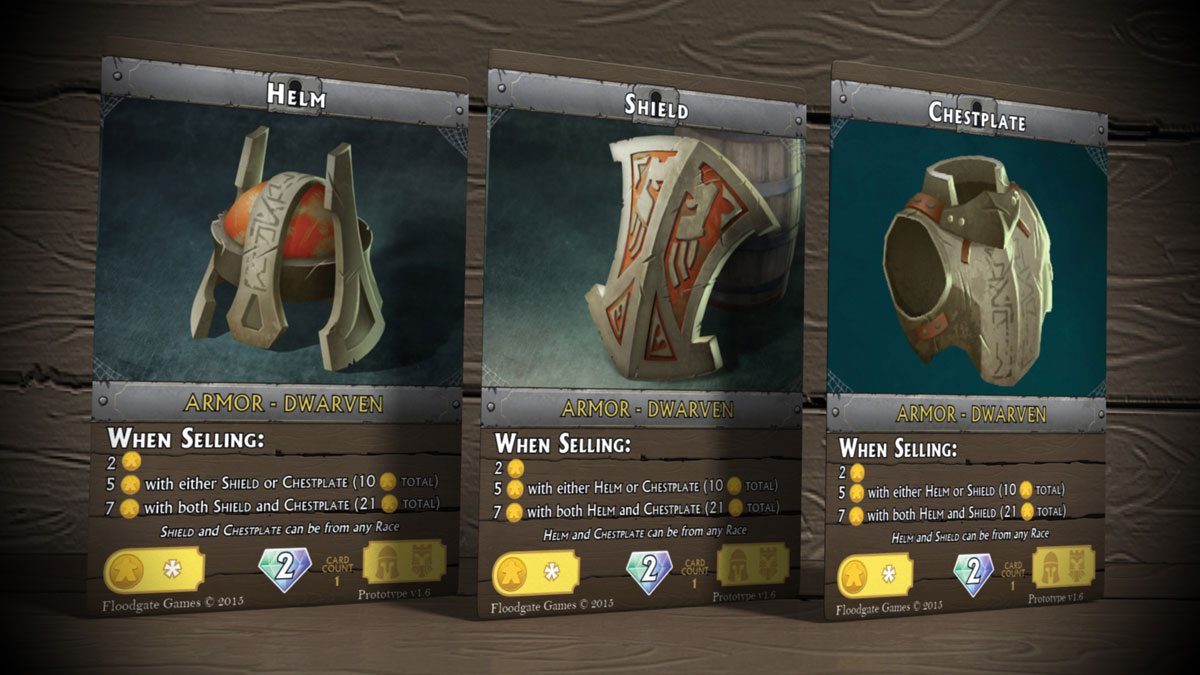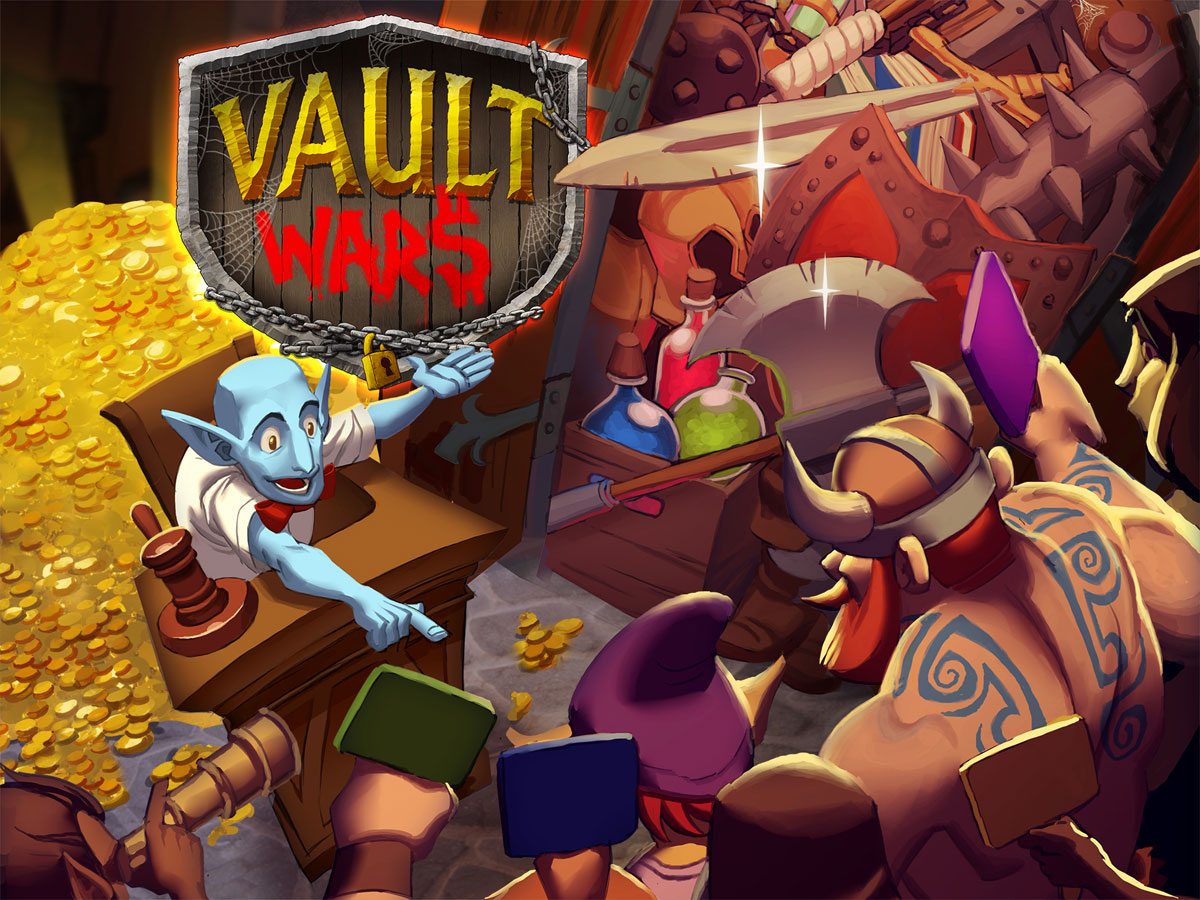Heroes manage to amass a lot of incredible loot and powerful weapons on their quests, but sometimes they die, leaving behind vaults full of treasure … and junk. In Vault Wars, you are an aspiring hero, bidding on these unclaimed vaults, hoping to go home with the most valuable haul.
At a glance: Vault Wars is an auction-based game for 3 to 5 players (though there is a 2-player variant), and takes about an hour to play. It’s currently on Kickstarter, with a pledge level of $20 for a copy of the game (or $45 for the deluxe edition that includes metal coins). There isn’t currently an age recommendation from Floodgate Games, but I would probably rate it about 10 and up (for experienced 10-year-olds). The game doesn’t have any content that’s inappropriate for younger players, but the auction/bluffing may be a little tricky for them.
New to Kickstarter? Check out our crowdfunding primer.

Components
The game will include:
- 73 Item Cards – Gems, Armor, Weapons, Artifacts, Junk, Dragon Eggs
- 16 Vault Cards
- 10 Aspiring Hero Cards
- 1 Loan Shark Card
- 60 Coins (1, 5, 10 value denominations)
- 12 Corruption Tokens


There are other items that may be included, depending on stretch goals reached, including the 12-card Worker Expansion, which adds workers that can be hired to give you additional abilities.
I played a prototype version that had some finished artwork and some unfinished, but you can see some of the finished artwork here. The illustrations, by Kelly McClellan (Ruse, Storm Hollow) and Jacqui Davis (Belle of the Ball, Epic Resort) are really great and fit the fantasy theme really well. If you’ve played Epic Resort, also from Floodgate Games, you’ll recognize some of the same characters since Vault Wars is set in the same universe.
The coins and corruption tokens will be cardboard punchout tokens, but my prototype set just had some plastic stand-ins. If you pay extra for the deluxe version, you’ll get metal coins from Fantasy Coins. I’ve seen some other coins they’ve made and they’re pretty nice.
How to Play
The rulebook is available to download here.
The object of the game is to score the most points by collecting valuable items in the auctions.
To set up, each player gets 2 Aspiring Hero cards, a number of vault cards (based on the number of players), and 20 coins. The remaining coins, corruption tokens, and the Loan Shark card are placed in a supply. The item cards are all shuffled together.

First, you will draft the vault cards (though you can skip this the first time you play): each player picks a vault card to keep, passes the rest of the hand to the next player, and then repeats until all vault cards have been chosen.
The game will last until all vaults have been auctioned off. Each round consists of these phases: Prepare Vaults, Auction, Get Paid, End of Round.

Prepare Vaults: Each player picks a vault card to auction off; these are revealed simultaneously, and will then be auctioned off in priority order. The player who played the vault serves as the Auction Master. Each vault shows draw, reveal, and peek numbers. The Auction Master draws that number of item cards and looks at them, chooses which cards to reveal (based on the reveal number), and then lets the other players peek secretly at the appropriate number of cards. Some vaults have special rules–they may let you throw out Junk cards and replace them, or choose which cards other players get to see for the peek, and so on.
Auction: The Auction Master sets an opening bid, and then the other players bid on the vault. The Auction Master doesn’t get to bid after the opening bid. Highest bid wins, and the money goes to the Auction Master (unless the Auction Master wins; then the money goes to the bank). The winner takes all the items and places them face-down. Some vaults have additional effects for the winner.

Get Paid: Once everyone has auctioned off a vault, you have a chance to sell items for cash. Each item has a gold value, though some are worthless (like Junk). Armor gives big bonuses for selling sets rather than individual cards. Discard anything you sell (and as much Junk as you’d like) and get cash from the bank. After this, players with fewer than 10 coins can take out a loan from the Loan Shark–you get 10 coins, but you also take a corruption token, which deducts points at the end of the game.

End of Round: You may now equip items that have an equip effect–equipped items generally don’t give you points, and may no longer be sold for cash. Finally, you must pay 1 coin per item you have for storage fees. If you can’t afford the storage fees, you have to trash items.
The rounds repeat until all the vaults have been sold. At the end of the game, you score points based on the diamond icons on each card, plus you get the bonus from one of your Aspiring Hero cards. Leftover cash is worth a little bit, and corruption tokens deduct from your score. The highest score wins.
The Verdict
Even though I’ve never actually watched Storage Wars, I like the idea of digging through discards to find the treasures. Vault Wars is a fun auction game, and–like the vaults themselves–there’s more to it than you may see on the surface.
As with most auction games, Vault Wars incorporates some psychology. As the Auction Master, you generally know exactly what’s in the vault and how much money it’s worth, but your opening bid isn’t just a simple economics problem. You can start with a high bid to prevent other players from getting away with a lowball offer on valuable loot or to fool people into thinking that it’s worth something. Bid too high, however, and you’re out a bunch of money for whatever was in the vault. Really want what’s in your vault? You have to consider whether starting with a low bid will make other players more or less likely to outbid you: will they think it’s worthless? Or will they go ahead and just buy it because they’ve got something that will let them sell off junk for cash?
That’s not to say that economics doesn’t play an important role. You need to remember while bidding on vaults that you’ll have to pay storage fees for anything you don’t end up selling for cash. Sure, that full set of dragon armor will be worth a lot of points to you, but not if you can’t afford to store it and have to sell it off for cash. (Or you could take a loan from the Loan Shark, but that’ll cost you points, too.)
The hero cards also play an important role, because it means that not everyone is after the same type of thing. Each item has its own points value, but, as they say, one man’s trash is another man’s treasure. There’s even a character (the Hoarder) who gets points for junk, which is worthless to everyone else.

Even the selection of which vault to offer up for auction each round involves a little bit of strategy. Each player picks a vault to sell and then they’re auctioned off in priority order–generally the vaults with fewer items get auctioned first. So if you need some cash to be able to bid, it might be wise to sell early. Since many of the vaults have special abilities or instructions, those can come into play as well. However, I’ve found that some of this strategy is difficult to pick up right away–you’ll probably need to play once to get the feel for how the game works, and then you’ll have a better idea for how to order your vaults the next time around.
Jon Gilmour, the designer of Vault Wars, made waves last year as a co-designer of Dead of Winter, which is an entirely different sort of game. Dead of Winter is a sprawling, epic game about surviving zombies (and each other). Vault Wars is a compact game that’s mostly just cards, though it still packs a pretty good punch for a $20 game.
Overall, I’ve enjoyed playing Vault Wars and I’m impressed with the amount of game packed into a pretty simple set of components. It’s one I’d recommend especially for people who like games with a good social element and “playing the player,” plus if you’re a fan of Storage Wars you may get a kick out of the reference.
For more about Vault Wars or to back the project, visit the Kickstarter page.






Good review, Jonathan. Keep up the great work!